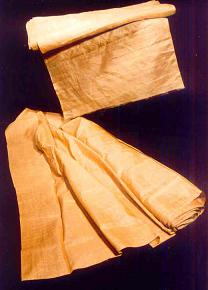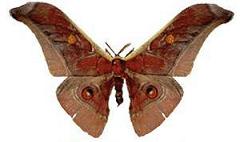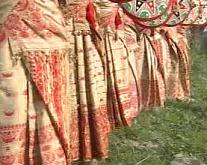 |
Best viewed @ 1024x768 resolution(IE7,FF)
The golden silk known as 'Muga Silk' (Muga Paat) is not only a unique silk product from Assam, but
also a symbol of rich Assamese culture and part of traditional attire of the region. It
is a pride of Assam.

Muga Silk Clothes
|
Muga silk is one of the many nature's gift to Assam. The speciality of this silk is it's
golden bright colour. "Muga" is derived from the Assamese word 'muga' meaning yellowish.
It is superior in every respect from the normal white silk
available all over the world. This silk is much more durable than the normal one. And interestingly
it's brightness improves with evry wash while the normal silk has to be very carefully washed.
Apart from normal dressings, it is used in other furnishing and decoration stuff too.
Muga clothes are so durable that it can be used for decades.
Muga Silk is supposed to be one of the costliest fabrics in the whole world.

Muga Moth - Antheraea Assamensis
|
Muga is produced from cocoons of 'Antheraea Assamensis' which is available only in Assam.
Muga worm('Muga Polu' in Assamese) also has the same lifecycle as silkworm,ie. egg, caterpillar, pupa and moth.
Antheraea Assamensis Moth's eggs (popularly known as seeds) are laid out on the Som and Soalu leaves to hatch out into caterpillars about 2mm long.
They grow rapidly, eat voraciously and end up about 30 mm long after four to five weeks.
During this time, they change skins four times.
After the final skin change straw frames are provided in which silkworms make its cocoon.
Cocoon making takes further eight days. Man interferes this life cycle at the cocoon stage
to obtain the silk, a continuous filament of commercial importance, used in weaving silk,
the dream fabric.
These silk worms yield a beautiful golden thread that is much sought after for its colour
and sheen. It takes the silkworm another three to four days to transform into a
pupa and another 15 days for the moth to emerge, but this is not allowed to take
place for all.
Considering that it takes two months to weave a saree and that it takes 1,000
cocoons to yield 125 gm of silk and that it takes about 725 gm to 1,000 gm for a saree,
one can figure out why these creations are so expensive.

Mekhela-Sadar of Muga Silk
|
It's the artistics creativity of the weavers in various corners of Assam
which add more to the natural gloden glow of Muga. Sualkusi which is situated in Kamrup
is famous muga silk weaving. The weavers embroiders various beautiful varities to the muga
wearings. The muga dress are usually very rich in colors and have embroidery of flowers, trees,
leaves,bihu related structures, etc. This makes the dress very spectacular and unique.
Traditionally muga is used to make mekhela - sadar (equivalent of Saree in Assam) for girls
and kurtas for boys. Till date it is considered to be the most sophisticated attire in Assam.
If you are visitng Assam, Muga silk is a must buy which is available in every silk shop in Assam.
In News
Vaishali Shadangule brings us Mekhla-Chadar and Muga Silk, the traditional Assamese attire at Wills Lifestyle India Fashion Week Autumn/Winter 2013
You can discuss or post any queries on Muga Silk in this forum.
|

Copyright © 2007-2008 onlinesivasagar.com(Abhijit Borah)
|
 |